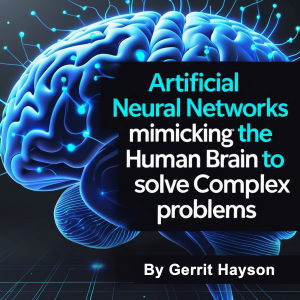

Artificial Neural Networks
Gerrit Hayson
This audiobook is narrated by a digital voice.
The human brain, with its intricate network of approximately 86 billion neurons, represents one of the most sophisticated computational systems ever observed in nature. Each neuron connects to thousands of others through synapses, creating a vast web of interconnected pathways that process information, store memories, and generate thoughts. This biological marvel has long captivated scientists and engineers, inspiring them to create artificial systems that could replicate even a fraction of its remarkable capabilities.
The journey to understand and mimic the brain's architecture began in the early 20th century when scientists first began to comprehend how neurons communicate. Santiago Ramón y Cajal's groundbreaking work in neuroscience revealed that the nervous system consists of discrete cells that communicate through electrical and chemical signals. This discovery laid the foundation for what would eventually become the field of artificial neural networks.
In 1943, Warren McCulloch and Walter Pitts published a seminal paper titled "A Logical Calculus of the Ideas Immanent in Nervous Activity," which introduced the first mathematical model of an artificial neuron. Their model, though simplified compared to biological neurons, captured the essential concept of how neurons receive inputs, process them, and produce outputs. This mathematical abstraction became the building block for all future neural network architectures.
Duration - 43m.
Author - Gerrit Hayson.
Narrator - Digital Voice Matt G.
Published Date - Monday, 20 January 2025.
Copyright - © 2025 Gerrit Hayson ©.
Location:
United States
Description:
This audiobook is narrated by a digital voice. The human brain, with its intricate network of approximately 86 billion neurons, represents one of the most sophisticated computational systems ever observed in nature. Each neuron connects to thousands of others through synapses, creating a vast web of interconnected pathways that process information, store memories, and generate thoughts. This biological marvel has long captivated scientists and engineers, inspiring them to create artificial systems that could replicate even a fraction of its remarkable capabilities. The journey to understand and mimic the brain's architecture began in the early 20th century when scientists first began to comprehend how neurons communicate. Santiago Ramón y Cajal's groundbreaking work in neuroscience revealed that the nervous system consists of discrete cells that communicate through electrical and chemical signals. This discovery laid the foundation for what would eventually become the field of artificial neural networks. In 1943, Warren McCulloch and Walter Pitts published a seminal paper titled "A Logical Calculus of the Ideas Immanent in Nervous Activity," which introduced the first mathematical model of an artificial neuron. Their model, though simplified compared to biological neurons, captured the essential concept of how neurons receive inputs, process them, and produce outputs. This mathematical abstraction became the building block for all future neural network architectures. Duration - 43m. Author - Gerrit Hayson. Narrator - Digital Voice Matt G. Published Date - Monday, 20 January 2025. Copyright - © 2025 Gerrit Hayson ©.
Language:
English
Start
Duration:00:43:29